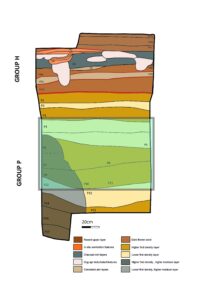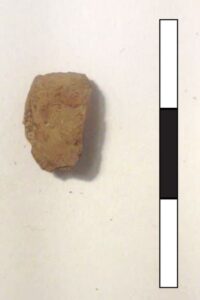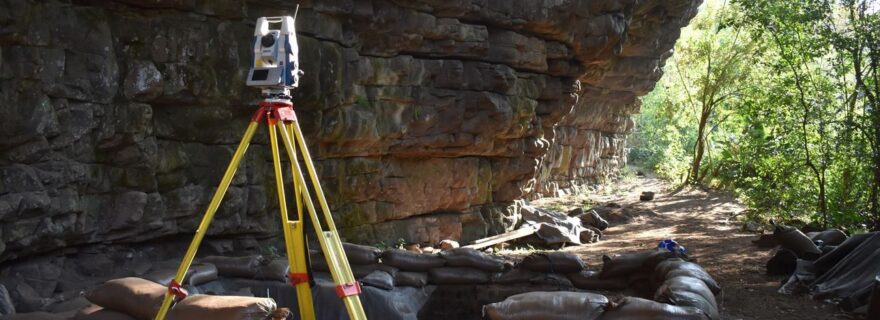Deciphering the Middle to Later Stone Age transition in South Africa from a stone tool perspective
Viola C. Schmid, the new postdoc in the project ‘Finding resolution for the Middle to Later Stone Age transition in South Africa’, is analysing the stone artefacts of Umhlatuzana Rock Shelter.
The Middle to Later Stone Age transition (50,000 to 20,000 years ago) is a major transition in social and territorial organisation in southern Africa. The character of technological change, its timing and functional implications are so far ill-understood. Dr Schmid has come to Leiden to study the important lithic assemblages of one of the rare sites documenting this transition, Umhlatuzana Rock Shelter.


The Middle to Later Stone Age transition
The transition from the Middle Stone Age (MSA) to the Later Stone Age (LSA), between 50,000 and 20,000 years ago in South Africa is so far poorly documented and understood. Although not linked to the rise of a new hominin species, this phase is crucial in cultural evolution, as past people developed new technologies to cope with their environment. In the preceding MSA, hunter-gatherer societies used primarily various stone points, while LSA toolmakers pursued the production of miniaturized toolkits and microliths. Other novelties of the LSA concern the ample range of organic artefacts such as worked suid tusks, ostrich eggshell beads, fishing equipment, and wood items. The differences in the material cultural repertoire between the MSA and the LSA seem to correlate with a major change in the way of living, including organisation of the everyday life, food procurement and hunting strategies, raw material provisioning, mobility patterns, and land use. The nature, timing and tempo of factors that triggered all these behavioural innovations, still require further investigation.
Current ‘hot issues’ are:
- Did unstable climatic conditions in the run-up to the most severe and coldest part of the last Ice Age (Last Glacial Maximum: ca. 24,000 – 18,000 years ago) play an important role as driving forces?
- And did the behavioural shift happen regionally quasi-simultaneously?
- Finally, did the process of change occur abruptly, implying discontinuity, or rather gradually, implying continuity?

Umhlatuzana Rock Shelter as a striking case study
Umhlatuzana Rock Shelter is located in the Province KwaZulu-Natal, South Africa, approximately 35 km west of Durban along a steep cliff at the edge of the Umhlatuzana River valley, ca. 100 m above the river. After the discovery in 1982, a brief rescue excavation was conducted by Jonathan Kaplan in 1985. New excavations by Leiden University were carried out in 2018 and 2019 directed by Gerrit Dusseldorp within the research project ‘Finding resolution for the Middle to Later Stone Age transition in South Africa’. The re-excavations yielded important insights into the stratigraphic integrity of the site as well as the dating, and numerous lithic artefacts.
Umhlatuzana Rock Shelter contains a virtually continuous archaeological sequence spanning the last 70.000 years. The lower MSA occupations are generally associated with early expressions of complex behaviour, i.e. comparable with the cognitive abilities of living people. Among these are the manufacture of specific stone tools, heat treatment to improve the knapping properties of the rocks, the production of adhesives for hafting, fabrication of personal ornaments, and expressions of symbolism. However, what makes Umhlatuzana Rock Shelter an excellent case study and why it is in focus of this analysis are the continuous occupations throughout the late MSA and the transition to the LSA. By examining the stone artefact assemblages from these layers, I will determine, what strategies knappers used to produce their tools, what techniques they employed, and what tools they manufactured. This will help me gain crucial insights into the technological inventions and cultural developments at the end of the MSA and the beginning of the LSA.
Technological innovations
For my PhD, I analysed MSA layers with an age of older than 72,000 years from the nearby site of Sibudu Cave. The study revealed that past craftspeople fabricated, besides other points, highly diagnostic pieces with serrated edges by the application of pressure flaking that were most likely used as armatures delivered with either a spear-thrower or as arrows with a bow. Furthermore, I identified that the knappers of Sibudu implemented a specific core reduction strategy to produce blades and elongated blanks. Hence, I could demonstrate, contrary to the conventional opinion, that such technological innovations and developments arose this early in the course of the MSA.
A first glimpse of the stone artefacts from Umhlatuzana Rock Shelter already hints at changes with regard to raw material economy, blank production and tool manufacture in the archaeological sequence, especially in the section encompassing the Middle to Later Stone Age transition. The LSA occupations seemingly involve a higher proportion of quartz, the application of bipolar percussion, and a high frequency of bladelet cores, bladelets as well as small elements indicating a process of miniaturisation.






0 Comments